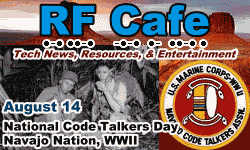|
 August 14 August 14
 Today is
National Code Talker's Day.
1777: Hans Christian Øersted, who discovered electromagnetism and after
whom the unit of magnetic field (H) is named, was born. 1888: A patent for the electric
meter was granted to Oliver
Shallenberger. 1919: A U.S. flying boat carried the first international air
mail delivery to Canada via the sea. 1932: Royal Philips made its 1 millionth radio.
1935: The Social
Security Act was signed into law. 1945: President Truman announced that Japan
had accepted terms for unconditional surrender, ending
World
War II. 1953: The whiffle ball, a ball that curved when it was thrown, was invented
by David Mullany for his 13-year-old son. 1959: The first meeting to organize the
American Football League was held. 1988: Car manufacturer and
racing star Enzo
Ferrari died. 1994:
Hubble Space Telescope photographs revealed that Uranus had Saturn-like
rings. 1997: Cosmonauts Vasily Tsibliyev and Alexander Lazutkin returned safely
home after a disastrous six-month mission aboard the
Mir space
station. 2000: A
Russian
submarine with 120 crewmen was reported stranded at the bottom of the Barents
Sea. Today is
National Code Talker's Day.
1777: Hans Christian Øersted, who discovered electromagnetism and after
whom the unit of magnetic field (H) is named, was born. 1888: A patent for the electric
meter was granted to Oliver
Shallenberger. 1919: A U.S. flying boat carried the first international air
mail delivery to Canada via the sea. 1932: Royal Philips made its 1 millionth radio.
1935: The Social
Security Act was signed into law. 1945: President Truman announced that Japan
had accepted terms for unconditional surrender, ending
World
War II. 1953: The whiffle ball, a ball that curved when it was thrown, was invented
by David Mullany for his 13-year-old son. 1959: The first meeting to organize the
American Football League was held. 1988: Car manufacturer and
racing star Enzo
Ferrari died. 1994:
Hubble Space Telescope photographs revealed that Uranus had Saturn-like
rings. 1997: Cosmonauts Vasily Tsibliyev and Alexander Lazutkin returned safely
home after a disastrous six-month mission aboard the
Mir space
station. 2000: A
Russian
submarine with 120 crewmen was reported stranded at the bottom of the Barents
Sea.
| Jan
| Feb | Mar |
Apr | May |
Jun | Jul |
Aug | Sep |
Oct | Nov |
Dec |
Note: These
historical tidbits have been collected from various sources, mostly on the Internet.
As detailed in
this article, there
is a lot of wrong information that is repeated hundreds of times because most websites
do not validate with authoritative sources. On RF Cafe, events with
hyperlinks have been verified. Many years ago,
I began commemorating the birthdays of notable people and events with
special RF Cafe logos.
Where available, I like to use images from postage stamps from the country where
the person or event occurred. Images used in the logos are often from open source
websites like Wikipedia, and are specifically credited with a hyperlink back to
the source where possible.
Fair Use laws permit
small samples of copyrighted content.
|
 August 14
August 14